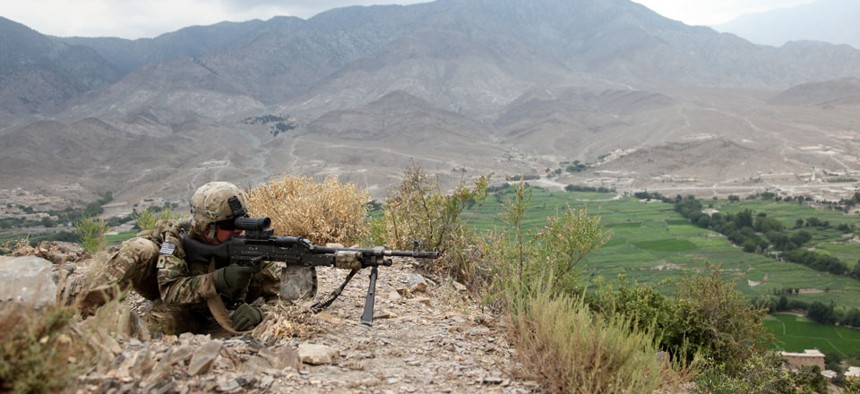Army Wants a Non-Satellite Radio That Works Over Mountains and Fits in a Backpack

A soldier provides security from a hilltop during a patrol in Paktia province in August. Defense Department
The service is pushing the laws of physics, some observers say.
The Army wants to develop a long range broadband backpack radio based on technology the service first used in Vietnam. But back then, the radios required antennas the size of billboards to augment expensive commercial satellite communications.
The Army Communications Electronics Research and Development Engineering Center, Space & Terrestrial Communications Directorate, seeks industry input on the development of a backpack radio that uses tropospheric scatter (also called troposcatter) communications, which bounce signals off the troposphere with a range as far as 600 miles, thereby overcoming the line-of-sight range of tactical FM radios.
The use of troposcatter radios for long range communications on the battlefield would help whittle down the Pentagon’s commercial satellite bill. The Defense Science Board reported on June 20 that Defense pays roughly $640 million a year for commercial satellite service, a tab expected to grow to between $3 billion and $5 billion over the next 15 years.
The Army used tropsoscatter as the backbone of its countrywide “Backporch” communications system fielded in Vietnam in the 1960s under the direction of signal officer Emmett Paige Jr., who went on to serve as Assistant Secretary of Defense for Command, Control, Communications, and Intelligence from 1993 to 1997. The system required high-gain billboard-sized antennas in Vietnam, as propagation losses from troposcatter communications are very high; only about one billion-billionth of the transmit power is available at the receiver.
The Army and Air Force both fielded extensive troposcatter systems for fixed communications in the first Iraq War in 1990-1991, but after that, the system fell out of favor as all the military services embraced satellite communications. Now the Army once again wants to tap into the technology to support both fixed and on-the-move communications.
But some are skeptical. Mark Yamamoto, director of government marketing for troposcatter equipment manufacture Comtech Systems who first started working with the technology in the Air Force in 1978, said the Army is pushing the laws of physics in trying to stuff a troposcatter system into a backpack radio. The plan “won’t work,” he said.
Retired Air Force Brig. Gen. Bernie Skoch, a defense industry consultant with extensive communications experience, said new digital signal processing technology and computer based radios could help shrink the size of troposcatter radios.
Yamamoto said Cromlech has developed a transportable version of its AN/TRC-170 troposcatter system with a small, 2-meter antenna that fits into five transit cases. The total weight is about 800 pounds. That’s about as small as it can get, Yamamoto said. This transportable unit has a range of 100 miles and can transmit data at the rate of 16 mbps, much faster than tactical satellite radio systems.
The Army uses this system in Afghanistan today, Yamamoto said, to communicate with forward units masked by mountains or ridge lines, which inhibit line-of-sight communications. The Army said this troposcatter system is expected to decrease the reliance on military and commercial satellites, which can be expensive “and cause latency issues that for some units, such as Patriot [missile] batteries, cannot be tolerated.”
Troposcatter systems definitely offer a cost savings compared to the cost of satellite air time, Yamamoto said. The transportable AN/TRC-170 costs about $500,000. Cromlech compares its costs to a three node satellite link planned for the Middle East and said the troop gear “paid for itself in about six months” worth of satellite time.



